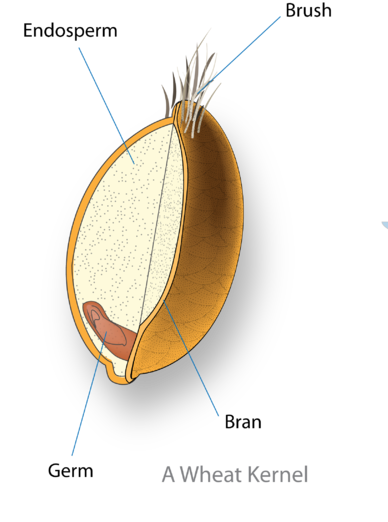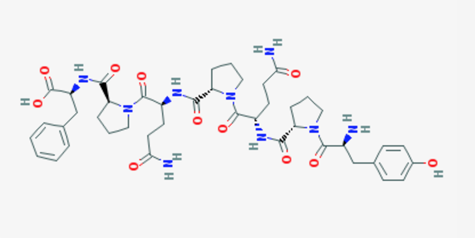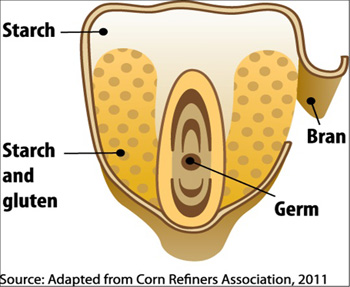What is Gluten and how to identify it?

What is gluten?
Gluten is a mixture of proteins found in wheat , and rye, barley and triticale. Gluten helps foods maintain their shape, acting as a glue that holds food together. The gluten protein complex accounts for 75 to 85% of the total protein in bread wheat. It is conjoined with starch in the endosperm of various grass- related grains.
Gluten proteins are termed prolamins. It is a protein that is attached to starch in the endosperm of various grass-related grains. Wheat prolamins are called gliadins and glutenins, barley prolamins are hordeins, rye prolamins are secalins and oats prolamins are avenins.
What is the structure of gluten (prolamins) protein?
Prolamins are a group of plant storage proteins found in the seeds of cereal grains: wheat (gliadin), barley (hordein), rye (secalin), corn (zein), sorghum (kafirin) and as a minor protein, avenin in oats. They are characterised by a high glutamine and proline content and are generally soluble only in strong alcohol solutions. Some prolamins, notably gliadin, may induce celiac disease in genetically predisposed individuals.

Wheat gliadin protein region - amino acids 43-49- showing high proline presence.
See: Effect of two synthetic alpha-gliadin peptides on lymphocytes in celiac disease: identification of a novel class of opioid receptors (Ref 1)
From abstract: "Our results suggest that alpha-gliadin-(43-49), Tyr-Pro-Gln-Pro-Gln-Pro-Phe, is closely related to the active fragment..." read abstract
See also:The structure and properties of gluten: an elastic protein from wheat grain.
Abstract: "...The wheat gluten proteins correspond to the major storage proteins that are deposited in the starchy endosperm cells of the developing grain. These form a continuous proteinaceous matrix in the cells of the mature dry grain and are brought together to form a continuous viscoelastic network when flour is mixed with water to form dough. These viscoelastic properties underpin the utilization of wheat to give bread and other processed foods. One group of gluten proteins, the HMM subunits of glutenin, is particularly important in conferring high levels of elasticity (i.e. dough strength). These proteins are present in HMM polymers that are stabilized by disulphide bonds and are considered to form the 'elastic backbone' of gluten. However, the glutamine-rich repetitive sequences that comprise the central parts of the HMM subunits also form extensive arrays of interchain hydrogen bonds that may contribute to the elastic properties via a 'loop and train' mechanism. Genetic engineering can be used to manipulate the amount and composition of the HMM subunits, leading to either increased dough strength or to more drastic changes in gluten structure and properties..." read full article
Why are Proline rich proteins are hard to digest?
In normal digestion long strands of protein are broken down by digestive enzymes. The enzymes cleave or break off groups of amino acids called peptides. The majority of these peptides can be further broken down, absorbed through the intestine and then transported and used in the body. Proline and glutamine, however, are two amino acids that are difficult to digest. Neither proline nor glutamine are classified as essential amino acids. It is the high proline and glutamine content in gluten that prevents the proteins from being completely broken down by the digestive enzymes. The long-term result of this is that toxic oligopeptides, proteins with up to ten amino acids, are present in the small intestine. Proline is degraded using an oxidase, which converts proline into glutamic acid using glutamate-gamma-semialdehyde. The glutamic acid in turn must be converted into glutamine, so that it can be transported to the brain, where it is necessary for protein synthesis.
How is gluten recognized by the immune system?
The immune recognition of gluten in coeliac disease
Coeliac disease, the most common intestinal disorder of western populations, is an autoimmune enteropathy caused by an abnormal immune response to dietary gluten peptides that occurs in genetically susceptible individuals carrying the HLA-DQ2 or -DQ8 haplotype. Despite the recent progresses in understanding the molecular mechanisms of mucosal lesions, it remains unknown how increased amounts of gluten peptides can enter the intestinal mucosa to initiate the inflammatory cascade. Current knowledge indicates that different gluten peptides are involved in the disease process in a different manner, some fragments being ‘toxic’ and others ‘immunogenic’. Those defined as ‘toxic’ are able to induce mucosal damage either when added in culture to duodenal endoscopic biopsy or when administered in vivo, while those defined as ‘immunogenic’ are able to specifically stimulate HLA-DQ2- or DQ8-restricted T cell clones isolated from jejunal mucosa or peripheral blood of coeliac patients. These peptides are able to trigger two immunological pathways: one is thought to be a rapid effect on the epithelium that involves the innate immune response and the other represents the adaptive immune response involving CD4+ T cells in the lamina propria that recognize gluten epitopes processed and presented by antigen presenting cells. These findings are the subject of the present review.
Does corn have gluten? Is corn alright to eat if you are gluten sensitive?
Corn is a type of grain, but it's from a different branch of the grain family than the gluten grains wheat, barley and rye. Corn contains a substance known as "corn gluten," which sounds problematic for gluten sensitive people, but corn gluten isn't the same that affets people with celiac or gluten sensitivity.
Are there other foods
A number of recent studies have shown that just avoiding gluten is not enough for many, and they also need to avoid other foods in order to reduce the gluten antibodies and inflammation in the intestine. read about lectins

READINGS AND REFERENCES
1- Effect of two synthetic alpha-gliadin peptides on lymphocytes in celiac disease
2- The structure and properties of gluten: an elastic protein from wheat grain.
3- The prolamin storage proteins of cereal seeds: structure and evolution. - Review Article
Gluten and Gluten Sensitivity
What is Gluten and how to identify it? What is the molecular structure of gluten?
Gluten is a protein found in wheat. What part of the wheat grain is it located? How can you identify foods that contain gluten? ... read more.
What are the genes in the Human Genome responsible for Celiac Disease?There are two genes that are responsible for Celiac disease although other genes and environmental factors play a role in those that get the disease, since as many as 30-40% of the population may have the gene(s) but not show symptoms... read more.
Why is an immune response triggered against gluten in some individuals?How does gluten cause celiac disease?... read more
What is the difference between celiac disease and gluten sensitivity?Only 1% percent of the population has true Celiac disease. Many more have what is know as gluten sensitivity What is the difference between the two, and how to know which one you have... read more. Is gluten the only substance in wheat people are sensitive to? ... read more.
What are the ongoing Clinical Trials for Celiac DiseaseThere is still a lot that is not understood about how gluten's affect humans... many clinical trials are underway... read more
What are lectins -why are they toxic and cause illness?Both plants and animals contain lectins. What are they and why can they be very toxic to our bodies. Why do beans have to be soaked and properly cooked? What is the role of lectins in autoimmune disease? ...read more
Role of Lectins in InflammationAlthough gluten has been in the limelight for sometime, many people may not realize that other lectins may be causing digestive issues... read more
How to Enhance Flavor in Cooking

Flavor can be enhanced many ways... Umami is now the commonly used term by taste scientists for the fifth taste but brining, curing and dehydrating are also very effective methods.
- Adding flavor using Umami
- Brining and Curing
- How to Roast Tomatoes for Umami Flavor ...
- How to freeze zucchini blossoms
- Science of zucchini blossoms
- Dehydrating Foods -- Zucchini blossoms
- Science of Saffron
- Science and Health Benefits of Ginger
- Why dried shitake mushrooms have more flavor than fresh